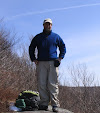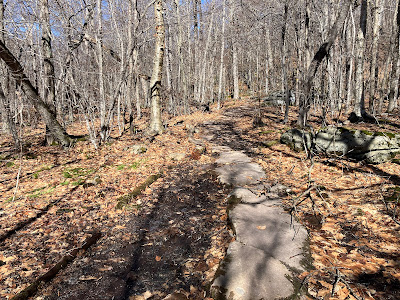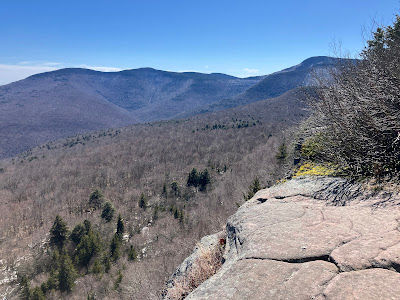For those unfamiliar with New York's Catskill Mountains, there is a list of 33 peaks
(formerly 35, two were removed in 2021 due to private land
issues) -
the 3500-footers - that one may climb to attain membership in the
Catskill 3500 Club. To earn the patch, you must climb four specific
peaks again in winter. I climbed my first Catskill peaks -
Wittenberg, Cornell and Slide - on a Boy Scout backpacking trip in 1966. Though 90% of my hiking since then has been in the White Mountains,
these are, in a sense, my home mountains.
In the spring these beautiful mountains, with their open forests of
hardwoods and hemlocks (replaced by spruce and fir only on the highest
peaks), are often mostly snow-free while the Whites are still locked in with rotten snowpack and crumbling monorails. Starting in 2004 I made numerous spring hiking trips to the Catskills with Carol, and also climbed a few peaks with friends Mike Dickerman, Laurie Rankin and the late Mark Klim, a devoted fan of this region. Accompanied by Mark and his wife Marilyn, I finished my all-season 3500
peaks in 2019 with a bushwhack to Balsam Cap and Friday Mountains. Due to the long drive and other factors, I kept putting off winter trips to re-climb the four
required peaks: Balsam, Blackhead, Panther and Slide. After a five-year
absence from the Catskills, last March I finally got down there to climb two of those winter peaks: Blackhead and Balsam.
This winter there was deep snow and good snowshoeing in the Catskills, but once again I hemmed and hawed about going down there. With the final week of winter approaching, the mountains were thawing out and ice was becoming prevalent. It looked like I might wait for another winter to climb those last two peaks. But with springlike sunny weather predicted for the middle of that final winter week, we made a literally last-minute decision to head down on Monday, March 17 after booking a cabin the previous evening.
Tuesday morning dawned bright and sunny, with temperatures predicted to rise from the 20s well into the 50s. I drove up steep, winding CR 47 to the trailhead for Giant Ledge and Panther Mountain and set off mid-morning, carrying spikes, Hillsounds and crampons, but no snowshoes as reports suggested there would be some ice but no deep snow on this primarily south-facing route.
A clever word play on the register at the trailhead.
There were a few strips of ice on the climb up to the ridge, but not enough to warrant traction. In fact, it turned out that 90% of this hike was ice-free bare ground.
The ascent to the ridge, though not long, is quite rocky.
Once on the ridge, the trail heads north along the flat crest towards Giant Ledge, crossing many step stones.
An abrupt ledgy rise, with a bit of easy scrambling, lifts you to the crest of Giant Ledge (3210 ft.).
A long cliff band on the east side of Giant Ledge offers a half-dozen rocky perches with excellent views. Though there are no open summits with 360-degree views, the Catskills
offer numerous and dramatic 180-degree vistas from flat sandstone
ledges. This vista looks NE to the rugged range of mountains traversed by the Devil's Path, the most challenging trail in the Catskills. L to R: West Kill, Hunter, Plateau, Sugarloaf, Twin, Indian Head, Plattekill and Overlook Mountains. The first six of these are 3500-ft. peaks.
Close by to the SE are Wittenberg, Cornell and Friday Mountains in the Burroughs Range. This range comprises the heart of the 47,500 acre Slide Mountain Wilderness.
There are designated campsites on the flat,wooded crest of Giant Ledge. Because the hike is only 3 miles round trip with 1000+ ft. of elevation gain, this area is very popular on weekends.
On the west side of the ridge there is one small viewpoint that looks across to two wooded peaks in the Big Indian Wilderness: Fir Mountain (L) and Big Indian Mountain (R).
One of several more east-facing perches on Giant Ledge.
From this spot Slide Mountain, at 4180 ft. the highest of the Catskill peaks and my objective for the following day, comes into view.
There was consistent ice on the north-facing descent into the Giant Ledge-Panther col. Time for the spikes.
The col, cloaked in ridge hardwoods, was mostly bare.
This ice flow had looked intimidating in recently posted pictures, but it had softened up in the warm sun and was easily surmountable in spikes.
A fun scramble through a typical Catskill ledge band.
Partway up the south slope of Panther a side path leads to a a magnificent outlook, one of my favorite spots in the Catskills.
I love the angle on Wittenberg, Cornell and humpbacked Slide, with Giant Ledge in the foreground.
Zoom on Slide. Lots of snow on the north-facing slopes. The slide for which the mountain was named fell in 1820 and is completely revegetated. It came down on the extremely steep NE face of the mountain, which is hidden by a spur ridge from this angle.
Hardwoods predominate in the Catskills up to ~3500 ft., and in these upper elevations there are many neat open glades of gnarled trees.
Higher up, into the conifers.
The trail was a ribbon of ice on the long, nearly level crest of Panther.
Just before the summit there is an outlook on the right that requires a short scramble.
Though still providing a decent panorama of the Devil's Path, the view here was less open than what I remembered from my last climb of Panther in 1985. My first ascent of Panther was on a Boy Scout backpacking trip in 1967.
This icy ledge appeared to be the high point of this 3720-ft. peak.
I continued north along the ridge about 0.2 mile to visit two more viewpoints.
Peering down into the valley of Panther Kill, a stream that flows eastward off the mountain.
The more northern viewpoint provided a look at the long spur ridge that runs eastward off Panther, forming the south side of the Panther Kill valley. This ridge would provide an interesting bushwhack route from the road on the floor of Woodland Valley.
On that ridge are two unusual open meadow areas called "Beech Flats" by Dr. Michael Kudish in his fascinating and authoritative book, The Catskill Forest: A History. The upper of these meadows can be seen in the center of the photo.
Looking back up at a steep pitch.
Neat old yellow birches.
I returned to the outlook on Panther's south slope for some relaxation in the late afternoon sun.
Slanting light at Giant Ledge.
Last look at Panther Mountain before heading down. One peak to go!






































No comments:
Post a Comment